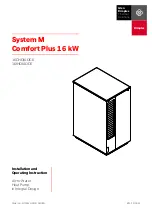
Page 5
RATE ADjUSTMENT
START-UP PROCEDURE
Check the oil level as described in the
“
LUBRICATION
”
section of this manual. Fill tank 1/2 full of water to get loaded radius.
Open the tank outlet valve and any other valves which would restrict the flow of liquid to, or from, the pump. Remove one
of the plugs from the bottom of the inlet manifolds to see if the fluid is up that far and to remove any air locks. Put the plug
back in when all the air escapes. The pump should prime itself after pulling the implement a few feet with the clutch engaged.
Important: The pump must not run more than 50 feet without fluid in it. If the pump fails to prime after trying the
above procedure, remove the inlet manifold plugs to see if there is fluid to the inlet manifolds. If difficulty persists,
refer to the
“
TROUbLE SHOOTING
”
section of this manual.
If pump does not prime, it may be necessary to set the rate adjusting pointer to maximum and remove two spray nozzles (to
prevent a high pressure build-up). Drive forward until the pump primes and begins pumping, replace the two spray nozzles,
reset the pump, and check for any leaks resulting from loose fittings, hoses, etc. After all checks have been made, add
chemical and water to fill the tank.
This PUMP is SHIPPED
WITH OIL.
NOTICE! ! !
3
3
2
1
1
2
Application rate for the Lil’ Thumper is determined by using
the slide chart included with the pump. Complete instructions
are on the back of the slide chart. Pump output is determined
by the drive wheel loaded radius, sprocket ratios, and pump
adjustment disc setting.
TO SET THE PUMP APPLICATION RATE:
NOTE: Adjustment is made when drive chain is connected
to drive wheel.
1. Loosen the two bolts holding the plated cast iron pointer
(#1) to the adjustment disc (#2).
2. Insert one finger of the special adjusting wrench (#3) into
the round hole in the numbered adjustment disc as shown.
Turn the adjustment disc clockwise or counter clockwise
to the desired setting. Pointer bolts need to be moved to
center hole for minimum or maximum settings.
3. Retighten the two bolts holding the pointer to the adjust-
ment disc.
Remember that the slide chart is based on spraying water.
Because of variable factors such as differing solution weights,
wheel slippage, etc. ACTUAL FIELD CALIBRATION SHOULD
BE DONE to insure the desired rate being applied. Refer to
the back of the slide chart for an example of proper tip selec-
tion.
NOTE: Remove the drive chain from the ground
drive wheel when traveling to and from the field to prevent
possible loss or damage to the chain
.
NOTICE!!!
This PUMP is SHIPPED
WITH OIL
FILL EACH PUMP CAvITy WITH 2/3 QT. SAE-30
NON-DETERGENT OIL or fill until oil comes out
the check plug. On a Double Piston Pump (PP2),
fill both sides of housing (requires 1-1/3 qt.).
Rev 1
AP21002
Optimum Operating Pressure 20-40 PSI.


































